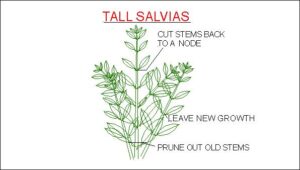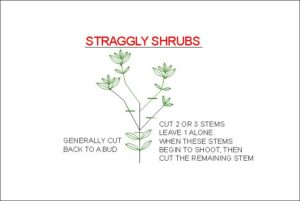Pruning Salvias

How to prune Salvias is very easy and can be done at any time of the year. “When you have time”, this is true if you live in the suburbs, but if you live in the country or live in a cold area which could be frost prone, then a little more care is needed.
The rule of thumb is to” always cut to a bud”, that looks as if it’s growing or about to shoot. Salvias put on new growth at the base of the stems as well as where you’ve cut the stem. This is especially true of the small leaf Salvias and perennial Salvias.
There are basically 4 types of Salvias:
- Tall Salvias,
- Salvias with perennial growth,
- small leaf Salvia shrubs
- clumping Salvias – these can be herbaceous or biennial and usually have rosette type growth. They don’t all have the same method of pruning.
Small Leaf Salvias: can be cut down to half or lower, usually to a good green bud if they are actively growing, but certainly not cut to the ground. If in a frost prone area, then just tip prune and leave any pruning until after the frosts are past. They need to be regularly pruned to keep their compact shape and keep those flowers coming.
Don’t worry about cutting off the flowers, they’ll be back in about 3-4 weeks time.
If the plant is straggly and has about 2 or 3 stems, cut 2 stems back to lower nodes and leave the other one. Wait until new growth appears before cutting down that last straggly stem. Often if you cut all the stems down all at once – especially if too severely, then the plant can go into shock and die.!. This method ensures that you don’t loose your plant when pruned.
Tip pruning helps to create more compact growth, this can be done at any time after planting out. Most salvias can be pruned back by 1/3 after flowering, removing spent flowering stems as they finish which can result in a second flush of flowers.
These include the greggii/ microphylla group, ‘Cookie’, Sth African Salvias, flocculosa, setulosa, coccinea group, ‘Superior Purple’, ‘Josh’, ‘Silkes Dream’, ‘Penny’s Smile’ etc.. and many other small leaf varieties.

Salvia ‘Penny’s Smile’ is just one of the many varieties of small leaf Salvias that need regular pruning to keep the plant in good shape.
When to prune small leaf Salvias?. approx twice a year. Usually in the Autumn, when they are looking straggly after Summer – it’s a good time to clean up the whole plant, get rid of any weak and dead little twigs and any old growth.If you are in a cold area, then just dead head and leave the real pruning until all frosts are over, then prune back to a good bud. After cleaning up the plants, it’s a good opportunity to manure/feed and mulch, as the plants are still growing and need some nourishment for the winter growth and a new flush of flowers.
And again in Spring. The new growth should be taken down by half. This ensures that the resulting new growth will be more sustainable for the upcoming hot weather. If you leave that new Spring growth, you’ll find that it’ll be the first to wilt when we have those hot days in October.
Lambley’s method of cutting back Salvia ‘Celestial Blue’, ‘Pozo Blue’, ‘Allen Chickering’ and ‘Bee’s Bliss’ are all hybrids or selections of Salvia clevelandii or S. leucophylla. They are evergreen or rather ever-grey shrubs grown as much for foliage effect as for their whorls of lovely mauve-blue flowers. We don’t prune this group in winter as they flower on the previous season’s wood so winter pruning would seriously effect flowering. We do tidy them up when blooming is finished but this doesn’t entail any drastic pruning just cutting off errant growth and spent flowering stems. The dramatic grey foliaged shrub, Salvia apiana, with its 150cm tall flower stems is treated similarly.
Perennial Salvias: These are usually plants with tall straight stems that come directly out of the ground, they produce new shoots at the base. These can be cut down to the ground, only after new shoots have appeared. This is also the time to feed and mulch, to keep the roots coll over the summer season. These plants don’t need touching again until late Summer coming into Autumn, when they need cutting down again.
These would include: Bog Sage, ‘Bethelii’, ‘Joan’, leucantha varieties, ‘Violet Eyes’, ‘Winter Red’, urica, and many others.

Salvia involucrata ‘Joan’ has perennial growth, so should be cut down to the ground when new shoots appear at the base of old stems.
Lambley’s method of pruning Salvia leucantha and its hybrids and Salvia mexicana clones flower with us until the first frosts. We then cut them to the ground and generally mulch them to protect the roots over winter. As we get late frosts here right into November (late spring) regrowth doesn’t really get going until early summer. These plants flower for us only during February, March and April (late summer-autumn) whilst in warmer areas they flower nearly the whole year round. Even if they are still in flower for you during late winter it is probably as well to cut them to the ground so that you get a fresh start each year as all the old daggy stems are removed.
Herbaceous Salvias: This type of pruning applies to all rosette. clumping Salvias including the biennial Salvias from the Middle East/ Turkey etc.. As this group send up one or more spikes of flower stems, these can be cut down after they’ve finished flowering or in Autumn. I like to leave a bit of a stem ( unsightly as they look), so you know where they are ( you don’t accidentally dig them up or tread on them and can keep an eye on snail and slugs). When the new growth is about to appear, even a clouch of fly wire over the plant will help to protect the new shoots from those midnight feast until the growth is strong enough to withstand their onslaught.

Salvia ‘Maynight’ is one of the many herbaceous Salvias that need to be pruned down to encourage a second flowering
These include: the nemerosa/ suberba/ x sylvestris group, Clary Sage, desoleana, indica, argentea,’ Rubin’, aethiopsis, eigii etc..
Lambley’s notes on cutting back Salvias
The Salvia nemorosa/superba/sylvestris complex is one of the most important groups of plants in my garden both in the mixed plantings in the dry garden and the mass planting in Molly’s Garden. These herbaceous Salvias are cut to the ground and I mean right to the ground twice a year, once in early May (mid autumn) and again in late December (mid-summer).
All of our Salvia nemorosa drifts are under planted with bulbs. We have to get the Salvias cut back and cleaned up and any remulching done early as the bulbs start to put their noses out of the ground by mid-May (late autumn). If the Salvias are not cut back by then we are likely to damage the bulbs either by trampling on them or by cutting the emerging foliage. We cut the Salvia nemorosa varieties right to the ground again just after Christmas even though they still have lots of flowers on them and still look fine. If we delay this cutting back to say mid January (mid summer) then we are less likely to get a good second flowering during late summer and autumn.
A couple of varieties don’t respond so well to this second cut back; that is they don’t rebloom well. They are Salvia x superb ‘Superba’, which I first saw shining in the Sissinghurst Castle gardens, and Salvia ‘Lye End’ which was raised by Miss Poole who gardened at Lye End and is most renowned for raising Achillea ‘Coronation Gold’. Treating this group of Salvias in this way means we have them flowering for twenty weeks in a gardening year.
Tall Salvias : These are the only group that is usually pruned after they have finished flowering. As these Salvias start flowering in Autumn, through Winter into Spring, many of the early flowering Salvias e.g. mexicana ‘Limelight’ can now be pruned and the later ones, pruned in early Summer, before it gets too hot for any of the new shoots.

Salvia ‘Costa Rican Blue’ is typical of the tall Salvias that produce woody stems, that need revitalising each year by regularly tip pruning.
In spring or early summer begin to prune down these tall Salvias by taking out the old tough stems and leaving the new shoots that are coming up from the base. If there are no basal shoots, then cut down to a node where you think there are buds – about 1/2 to 3/4 down the stem. New shoots should begin to show in a few weeks. If you are unsure, then adopt the above policy of cutting 2 stems and leaving 1 stem, then cutting that down when the others have begun to shoot. When the new shoots begin to appear, you can then see if you want to prune them down further or just leave the stems and new growth.
As these stems can become very woody after some years, to promote new growth, prune down 1/4 off the top which will produce new tip growth. Usually at the same time new basal growth should appear, indicating that the woody stems can be taken out, allowing good fresh strong stems to take over. But again if unsure, adopt the 2 stem, leave 1 stem policy. The new growth at the top of the old stems can be used as cuttings.
If in a cold or frost area, these tall Salvias may have been frosted, leave the blackened mess until after the frosts have passed. The blackened mess will protect the new shoots. Obviously clear away all blackened parts when the weather begins to warm up, there should be new shoots appearing at the base.
If in these cold and frosty areas, these tall Salvias need protection. – Plant in among or next to other hardy shrubs and trees, which will give protection, plant under deciduous trees- the tracery of the branches helps to break the frost. Plant near brick pathways and paved areas or areas that will absorb the heat – not concrete, as concrete is cold and reflects the heat/ sun.
 These include: iodantha, ‘Bluebird’, ‘purpurea’, involucrata spp, ‘Timboon’, ‘Romantic Rose’, karwinski group and many others
These include: iodantha, ‘Bluebird’, ‘purpurea’, involucrata spp, ‘Timboon’, ‘Romantic Rose’, karwinski group and many others
All Salvias need pruning to keep them tidy and sustainable to get them through the next hard season of hot summer weather or cold, windy (sometimes, occasionally) wet winters.


